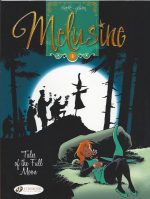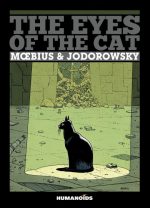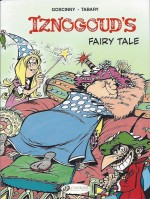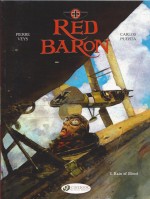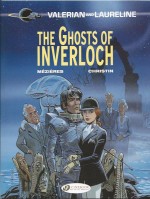
By Turk & De Groot, translated by Luke Spear (Cinebook)
ISBN: 978-1-905460-08-3
Seeing ourselves through other’s eyes is always a salutary experience and our Continental cousins in the comics biz are especially helpful in that respect as regards the core characteristics of being British
For some inexplicable reason most of Europe’s comics cognoscenti – most especially the French and Belgians – seem fascinated with us. Maybe it’s a shared heritage of Empires in Decline and old cultures and traditions in transition? An earlier age would have claimed it’s simply a case of “Know your Enemyâ€â€¦
Whether we look at Anglo air ace Biggles, indomitable scientific adventurers Blake and Mortimer, the Machiavellian machinations of Green Manor or the further travails of Long John Silver, the serried stalwarts of our Scepter’d Isles cut a dashing swathe through the pages of Europe’s assorted strip-magazines and albums.
Clifton was originally devised by child-friendly strip genius Raymond Macherot (Chaminou, Les croquillards, Chlorophylle, Sibylline) for iconic Tintin Magazine; a doughty True Brit troubleshooter who debuted in December 1959, just as a filmic 007 was preparing to set the world ablaze…
After three albums worth of material Рcompiled and released between 1959 and 1960 РMacherot left Tintin for arch-rival Spirou and his eccentric comedy crime-fighter forlornly floundered until Tintin brought him back at the height of the Swinging London scene and aforementioned spy-boom, courtesy of Jo-El Azaza & Greg (Michel R̩gnier).
These strips were subsequently collected as Les lutins diaboliques in French and De duivelse dwergen for Dutch-speakers in 1969.
Then it was back into retirement until 1971 when first Greg (in collaboration with artist Joseph Loeckx) took his shot; working until 1973 when writer Bob De Groot and illustrator Philippe “Turk†Liegeois fully revived the be-whiskered Brit for the long haul. They produced ten tales of which this – 7 jours pour mourir from 1979 – was the fourth.
From 1984 on, artist Bernard Dumont – AKA Bédu – limned De Groot’s scripts before eventually assuming the writing chores as well, until the series at last concluded in 1995.
…But Not For Long…
In keeping with its rather haphazard Modus Operandi and indomitably undying nature, the Clifton experience resumed yet again in 2003, crafted by De Groot & Michel Rodrigue for four further adventures; a grand total of 25 to date.
The setup is deliciously simple: pompous, irascible Colonel Sir Harold Wilberforce Clifton, ex-RAF, former Metropolitan police Constabulary and recently retired from MI5, has a great deal of difficulty dealing with being put out to pasture in rural Puddington. He thus takes every opportunity to get back in the saddle, occasionally assisting the Government or needy individuals as an amateur sleuth.
Sadly for Clifton – as with that other much-underappreciated national treasure Captain Mainwaring in Dad’s Army – he is too keenly aware that he is usually the only truly competent man in a world full of blithering idiots…
This particular tale however strays somewhat from well-trodden humour paths and indulges in some frantic action and sinister suspense bombastic whilst still resolutely going for comedy gold.
In this third translated Cinebook album – first seen in 2005 – the Gentleman Detective is notably absent as the tale opens in London at the secret Headquarters of MI-5. Veteran warhorse and ultra-capable spymaster Colonel Donald Spruce is having a little bit of a crisis…
A battled-scarred survivor of simpler times, Spruce longs for one last field mission, but is instead swamped with petty admin nonsense. That all changes in an instant as the computer boffins in charge of Betty – latest in the line of “Thinkover†super-calculators – discover a little problem.
In the age of automation, Betty controls every aspect of physical eliminations for the agency. It is an infallible electronic assassination expediter. Information on a target is fed in and Betty commences a contract, contacting outside agents to do the dirty work and providing all the details they will need to complete the commission. No hostile has ever lasted more than a week when Betty is concerned: she provides efficiency, expediency, economy and utter deniability…
Except now the harassed technos are enduring a severe tongue-lashing from Spruce who has noticed that the latest print-out is retired agency star and his old chum Harold Wilberforce Clifton. As Spruce fumes and fulminates the abashed boffins try to explain that the process is irreversible. They can’t contact the contractors to cancel the hit. Clifton is as good as dead…
With no other choice the Colonel frantically phones the retired agent and gives him the bad news. Our hero, unwilling to bow out gracefully, immediately goes on the run, using all his cunning and years of tradecraft to stay one step ahead of his faceless hunters. His stalkers however are seasoned professionals too and luck more than guile is the only thing saving him from an increasingly spectacular succession of devastating “accidentsâ€â€¦
Thematically far darker than previous tales, 7 Days to Die is nevertheless stuffed with hilarious moments of slapstick and satire to balance some pretty spectacular action set-pieces as frantic flight, devious disguise and even coldly calculated counterattack all fail to deter the implacable assassins. However as the climax approaches Clifton and Spruce individually come to the same stunning conclusion: this selection by Betty might not have been an accident after all…
Visually spoofing the 1970s’ original era of Cool Britannia and staidly stuffy English Mannerism with wicked effect, these gentle thrillers are big on laughs but also pack a lot of trauma-free violence into the eclectic mix. Delightfully surreal, instantly accessible and doused with serous slapstick à la Jacques Tati and deft, daft intrigue like Carry On Spying or Morecambe & Wise’s The Intelligence Men, this romp rattles right along offering readers a splendid treat and loads of to think about.
Original edition © 1979 Le Lombard (Dargaud-Lombard S. A.) by De Groot & Turk. English translation © 2005 Cinebook Ltd.



